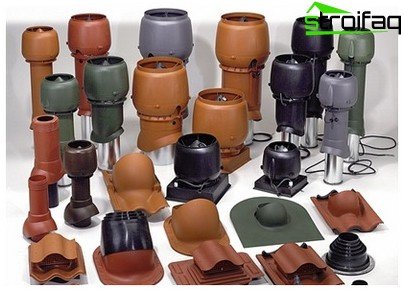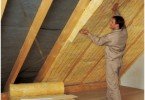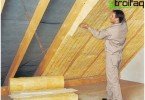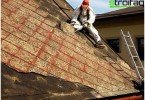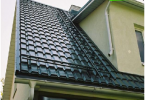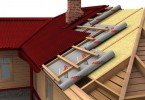Roofing is a complex system with many components: supporting structure, insulation, hydro and vapor barrier, various accessories, including roofing penetration. Each of the elements of the building performs its function, providing a reliable and durable roofing cake. The function of penetration is to ensure the tightness of the junction of various technological communications to the surface of the roofing. Until recently, this issue was solved with the help of ingenuity and various improvised means. Currently, manufacturers offer a variety of unified nodes suitable for use in different conditions. For each type of roof, they select their own passage unit, with an individual scheme. Consider the varieties, composition and features of roofing penetrations.
Content
- Purpose and design of roofing
- Types of roofing penetrations
- Features of the assembly of the passage passage for chimneys
- Universal roof seal
Purpose and design of roofing
As already mentioned, the roofing must be airtight over the entire surface of the roof. If this condition is not met, the temperature difference that takes place during the day contributes to the formation of condensate, some of which will be brought out, and some will settle on the waterproofing layer. In cold weather, the moisture remaining inside forms ice, which has a destructive effect on the roofing.
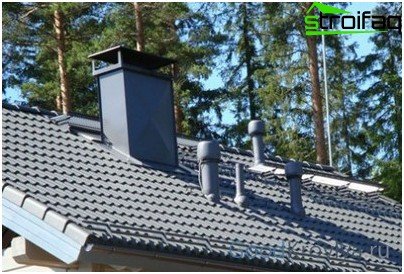
This is how roof penetrations of various communications on the roof look
Ventilation will help to avoid this, creating additional air circulation in the under-roof space. All available exits of pipes, chimneys, antennas, ventilation are carefully sealed, using for this purpose a sealant of roof passages of various configurations. Its design completely eliminates the penetration of moisture into the under-roof space.
So, roofing is called a special passage unit, which is used for mounting pipes for various purposes, antennas, ventilation shafts in places of passage through the roof. The modern market offers a variety of variations of such units, which allows for tight connections on the roofs of any type, with different coatings.
Their design looks, in general terms, as a hole in the ceiling, into which a metal pipe is inserted and installed on reinforced concrete glasses or directly on the roof. The thickness of the metal from which the penetration is made must be at least 1 mm. On roofs with a metal frame, standard roof penetrations are mounted using a glass of metal. When installing a penetration on a reinforced concrete floor, it would be nice to use slabs with ready-made openings for it. That is why it is advisable to determine the location of the penetrations during the design of the building.
Types of roofing penetrations
Roof penetrations are of several types, depending on what is displayed on the roof:
- Pipes, antennas, flagpoles.
- Sewer ventilation, which is installed to prevent the appearance of unpleasant odors in the house.
- Roof hatches, which provide access to the roof for maintenance and repair of chimneys, various communications.
- Indoor ventilation.
- Ventilation of the under-roof space with which excess moisture is removed from the attic and roof space.
The shape of the roofing unit depends on the design of the roof, the types of ventilation ducts used. Cross sections are:
- square;
- round;
- rectangular;
- oval.
According to the method of controlling air flows, ventilation roof penetrations are available in several versions:
- A valveless device in which ventilation is constantly in operation.
- Manual gear. Using a simple valve, the amount of air allowed is regulated, and if necessary, ventilation through this channel can be completely turned off..
- A device that enables remote valve control using automated systems.
Correctly selected roofing penetration will provide high-quality sealing of the junction of communications to the roof surface
Choose a roof penetration taking into account the following roof parameters:
- the amount of roofing;
- the distance between the roof ridge and the installation site of the penetration;
- slope angle;
- the size of the attic, if any;
- what materials the roof is made of;
- sizes of connected communications.
None of the listed criteria can be ignored, otherwise problems may arise either at the installation stage or during operation.
Features of the assembly of the passage passage for chimneys
Distinctive design features of the passage unit for the chimney are determined by fire safety rules. Since a sufficiently high temperature of the resulting furnace gases is transferred during operation to the elements of the chimney, the possibility of a roof fire is not ruled out.
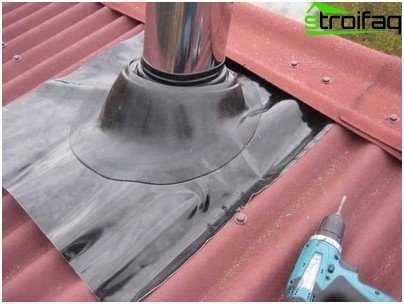
The installation of a roofing tunnel for a chimney has certain fire safety requirements
This applies mainly to roofs with a supporting structure made of wood. Therefore, in this case, the following requirements are imposed on the installation of the feed-through unit:
- the presence of a gap regulated by construction rules between the chimney pipe and flammable roof elements;
- in this section, the chimney should be treated with any material that reduces the fire hazard, for example, asbestos;
- at the place of passage through the roofing cake, the assembly should be mounted using a duct made of galvanized metal, in which the free space (between the walls of the duct and the chimney pipe) is filled with glass wool or other fire-resistant materials.
The chimney passage assembly through the roof can be installed on the roof slope or on the ridge. When mounting it on the ridge, it may be necessary to change the rafter system, and when installing the passage on the slope, the formation of an unnecessary pocket for snow is possible. To avoid possible leaks, an additional element is inserted under the ridge strip.
Universal roof seal
In addition to various modifications of roof penetrations on sale today you can find similar products of a new generation – a universal sealant of roof passages. This element differs in that it can be used on communications of any diameter. With the help of modern models it is possible to seal the outputs within 3 – 600 mm. They are suitable both for network and television cables, and for ducts and chimneys of a sufficiently large diameter. In addition, thanks to the conical design of these products with an angle of inclination of 20 degrees, they can be installed on pitched roofs with any slope.
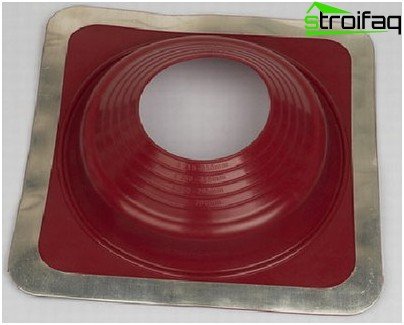
Universal roofing sealant is used when installing communications of any diameter and on roofs with any coating
A significant advantage of universal penetrations is the ability to use on various roofing: they work equally effectively on a metal profile and on slate. The elasticity of the penetration makes it possible to repeat the shape of any wave. High-quality silicone, from which universal sealants are made, is able to work in the temperature range from minus 74 to plus 260 degrees. In addition, silicone retains its properties even under very aggressive conditions. Compared to conventional rubber materials, silicone products last much longer..
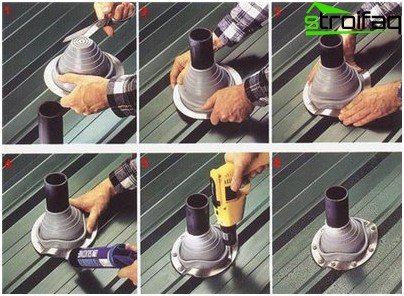
Installation guide for roofing
Installation of universal penetration is carried out in the following order:
- so that the connection is tight, the diameter of the ring of the selected seal must be 20% less than the diameter of the pipe. The excess part is cut off;
- so that the sealant is mounted easily, the pipe must be treated with a solution, for example, laundry soap;
- the usual flange compression will ensure a good fit to the roof along the entire profile. For a better fit of the flange, you can use special tools;
- after sealing the joint with a special compound, the penetration is fixed to the roof surface using self-tapping screws (installation step – not more than 35 mm).
The universal sealing of roof passages is in great demand due to its ease of installation, a wide range of applications and a high degree of sealing.
The correct selection and installation of roofing penetrations will ensure the tightness of the roofing cake, and this, as you know, is one of the main conditions for the strength and reliability of the roof, its long-term operation. Perhaps the information presented above will help someone independently carry out the conclusion to the roof of the chimney pipe or ventilation. But only professionals who have been engaged in roofing for many years know all the intricacies of installation of penetrations (and there are not so few of them), therefore it is better to entrust them with the performance of this work.


